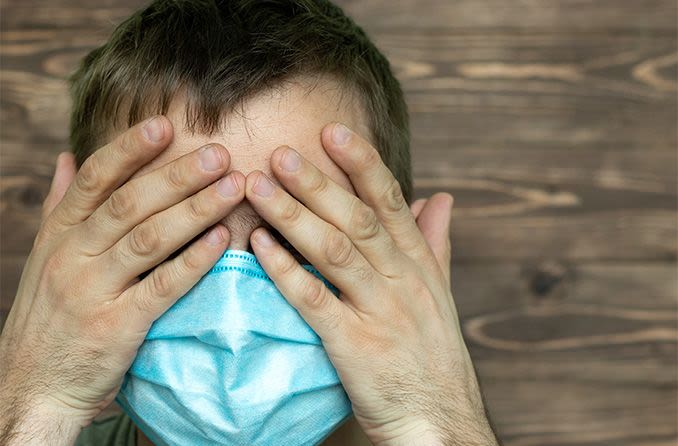Can You Get COVID-19 Through Your Eyes?

How the eyes provide a route of COVID-19 infection
When it comes to COVID-19 and the eyes, it appears the coronavirus can enter your body through the eye's conjunctiva. Since this is thought to be a minor route of infection, getting COVID-19 through your eyes is unlikely.
The conjunctiva is the clear, thin membrane that covers part of the white of the eye and the inner surface of the eyelids. Some evidence suggests conjunctivitis, which most of us know as pink eye, could be a symptom of COVID-19.
In June 2020, Review of Ophthalmology reported on a recent study published in Lancet Respiratory Medicine that sheds some light on this issue. Researchers in Hong Kong found that the COVID-19 coronavirus can infect the conjunctiva of the eye, but there is no evidence to date that the disease spreads from the eye into the lungs.
Kendrick C. Shih, MD, an ophthalmologist and one of the authors of the study, points out the research did not provide evidence that the virus spreads to the rest of the body through the bloodstream, and that "the study doesn’t examine whether the virus can then be spread from the conjunctiva of COVID-19 patients to others through tears, or through eye rubbing.”
SEE RELATED: COVID-19 and pink eye
Coronavirus transmission from the eyes is unlikely
The actual number of people with COVID-19 who show signs of conjunctivitis, however, is still a bit of a mystery.
A small-scale study published in March 2020 in the journal JAMA Ophthalmology found that among 38 COVID-19 patients hospitalized in China, 28 (74%) tested positive for the coronavirus on nasopharyngeal swabs and 12 (32%) had positive clinical signs of conjunctivitis (eye redness, swelling, watery eyes, or increased eye secretions).
But in another small study published in July 2020 in the journal Ophthalmology, researchers found that among 17 patients who tested positive for COVID-19 in Singapore, they detected no traces of the coronavirus in patients' tears, but the virus populated the patients’ noses and throats.
The study also cites a much larger study published April 2020, in The New England Journal of Medicine that found that among 1,099 patients with laboratory-confirmed cases of COVID-19 in China, only 0.8% showed signs of conjunctivitis.
“Despite this reassuring news, it’s important for people to understand that guarding your eyes — as well as your hands and mouth — can slow the spread of respiratory viruses like the coronavirus,” says AAO, which publishes the journal Ophthalmology.
In a press release issued in March 2020, AAO said, "health officials believe pink eye develops in just 1% to 3% of people with coronavirus."
SEE RELATED: Are sore eyes a symptom of COVID-19?
More likely methods of coronavirus spread
The American Academy of Ophthalmology (AAO) says the virus is thought to spread mostly by person-to-person contact through respiratory droplets produced when an infected person coughs or sneezes. The World Health Organization (WHO) says it also can be transmitted through droplets of saliva or mucus from the nose.
Infected droplets (or infected mucus) can end up in an uninfected person’s mouth or nose and potentially travel to the lungs, according to the U.S. Centers for Disease Control and Prevention (CDC). The AAO notes that these droplets might enter through your eyes, too. Mucous membranes throughout the body are the most susceptible areas for virus transmission.
The novel coronavirus, which causes a respiratory disease called COVID-19, also might be spread if someone touches an object or surface (such as a doorknob or countertop) where the virus is present, and then touches their mouth, nose or eyes, according to the ophthalmology group.
But as the AAO and CDC emphasize, contracting the virus from an object or surface is thought to be responsible for only a minority of cases. Transmissions of this manner can be mitigated by proper hygiene and hand washing.
How you can reduce coronavirus spread
So, what should you do to curb the spread of the current threat known as the novel coronavirus? Here are some tips:
Wash your hands frequently and thoroughly with soap and water. If you don’t have access to soap or water, clean your hands with an alcohol-based sanitizer.
Resist the urge to touch your eyes, nose and mouth.
Stay away from people who’ve been exposed to or contracted the coronavirus.
Cover your mouth and nose with a tissue when you cough or sneeze, or use the inside of your elbow. Throw tissues in the trash immediately after using them.
In addition, AAO says wearing glasses might block infected respiratory droplets from going into your eyes. However, they might not provide full protection, since droplets can still travel to your eyes through the exposed sides, tops and bottoms of the glasses. Wrap-around safety goggles might be a more effective alternative for those in direct contact with affected individuals.
Wearing a non-medical face mask outside your home also can help control spread of the coronavirus. In many cases, people who have the virus don’t realize they could be infecting others because they aren’t exhibiting any symptoms.
READ NEXT: Eye problems that could be related to COVID
Page published on Friday, April 3, 2020




